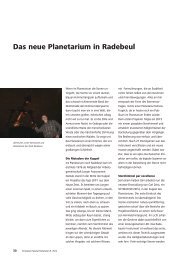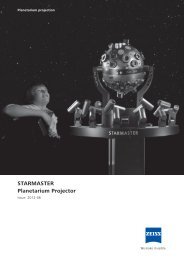Innovation Special Planetariums 9 - Carl Zeiss Planetariums
Innovation Special Planetariums 9 - Carl Zeiss Planetariums
Innovation Special Planetariums 9 - Carl Zeiss Planetariums
Create successful ePaper yourself
Turn your PDF publications into a flip-book with our unique Google optimized e-Paper software.
Wilfried Lang<br />
Vice President Planetarium Division<br />
4 <strong>Innovation</strong> <strong>Special</strong> <strong>Planetariums</strong> 9, 2012<br />
Editorial<br />
Passion to Win<br />
Dear Planetarium Friends,<br />
Could <strong>Carl</strong> <strong>Zeiss</strong> possibly have had the slightest idea of what his fine mechanics and<br />
optics workshops founded in Jena in 1846 would have become in 2012? Could he<br />
have foreseen, at a time when a couple of his employees were screwing together the<br />
first microscopes by candlelight, that 166 years later his little business would have<br />
developed into a world famous global enterprise?<br />
I think nobody could ever have imagined that, and I also believe that a company<br />
with such an eventful history is simply unique.<br />
Could <strong>Carl</strong> <strong>Zeiss</strong> know, when he got Prof. Ernst Abbe of the Friedrich Schiller University<br />
to join his crew, that he was not only a highly gifted scientist, but that he<br />
would also develop into a skilful business manager and social reformer the likes<br />
of which had not been seen before? When, after <strong>Carl</strong> <strong>Zeiss</strong>’ death, Ernst Abbe<br />
transformed the Company into a foundation enterprise in 1891, he enshrined in its<br />
Charter social standards for every <strong>Zeiss</strong> employee that were downright revolutionary.<br />
Ernst Abbe transferred his property of the <strong>Carl</strong> <strong>Zeiss</strong> Company to the <strong>Carl</strong> <strong>Zeiss</strong><br />
Foundation, just as Otto Schott also contributed his stock in the Jena glassworks to<br />
the Foundation. Even today, all <strong>Zeiss</strong> and Schott employees are still bound by this<br />
Charter.<br />
Over almost 100 years <strong>Carl</strong> <strong>Zeiss</strong> has developed into the leading optics company<br />
worldwide. At the end of World War II, the American troops saw a chance to access<br />
<strong>Carl</strong> <strong>Zeiss</strong> technologies, competences and technical human capital to secure them<br />
for the US Armed Forces. They only stayed for a few weeks in Jena, as in accordance<br />
with the decisions of the Yalta Conference the Thuringia region was part of the Russian<br />
occupation zone. They left Jena with 77 executives and scientists, including the<br />
entire management of <strong>Carl</strong> <strong>Zeiss</strong>. In this way, design plans and patents made their<br />
way into the American occupation zone, to Heidenheim in Swabia to be precise.<br />
A new factory for optical instruments was supposed to be built not far away, in<br />
Oberkochen.<br />
After the bombings of March of 1945, the main <strong>Zeiss</strong> facility in Jena was a field of<br />
rubble. The Russian occupiers took it over with the goal of leaving only 6 % of the<br />
manufacturing capacity in Jena. Two hundred and seventy-four managers and scientists<br />
had to follow the dismantled machinery into the Soviet Union to help build up<br />
an optical industry there.
















